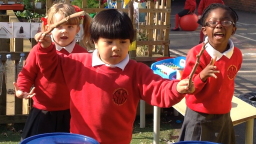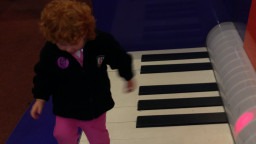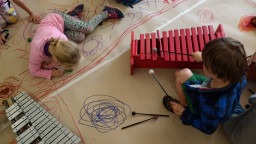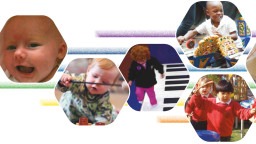Hearing and Listening
As stated in Musical Development Matters, research suggests that the human fetal auditory system is functional around the 25th week of gestational age (Draganova, 2018).
As the auditory system continues to develop, responsiveness to sound becomes more sophisticated and research indicates that in the latter stages of the third trimester babies are familiar with and respond to the maternal voice (Renaud, 2012). Hearing is an integral aspect of musical development, it is therefore important to consider that musical development may begin in the womb.
The listening abilities of young children has been researched on many occasions. Sandra Trehub offers an overview of studies in this area in her article aptly titled Infants as Musical Connoisseurs (2006). Throughout this article Trehub highlights the acute listening skills of infants and young children. It is possible to suggest that humans appear to be born with an acute sense of hearing. Within a nurturing environment this sense of hearing can be supported to enable young children’s listening skills to develop.
Listen carefully to the young infant in the following clip:
What can we see and hear happening in this clip?
Here are some suggestions:
- Acute listening skills
- Turn taking
- Time allowed for the baby to respond
- Baby mimicking the adult’s vocal melodic shape (listen carefully to how the baby at times imitates the adult’s voice moving up and down)
Points to consider
We don’t know how often this has happened before, how much the baby had heard this in utero, if is this a familiar adult.
Observe the 17-month-old in the following clip:
What can we see and hear happening in this clip?
Here are some suggestions:
- Physical response to live music
- Enjoyable experience
- Anticipates changes in the music and appears to anticipate when the music is going to stop
Points to consider
Regular live performances in settings are not common place, explore possibilities of live musicians performing in the setting, this could be parents who play instruments to bands and orchestras who offer performances for young children. Orchestras often have ‘Learning and Participation’ programmes, explore local bands and orchestras to seek out possibilities.
Burke’s research (2013) found that there was a limited range of music played in EY settings and there were 5 ‘top’ genres of music that were drawn upon.
These were:
- Nursery Rhymes
- Classical
- Pop
- Christmas
- ‘Relaxing’
This demonstrates that the young children attending the early childhood settings involved in the research were exposed to a very limited number of genres of music.
David Hargreaves coined the term ‘open-earedness’ (1982), he predicted that younger children maybe more ‘open-eared’ to forms of music regarded by adults as unconventional. Early Childhood Educators can support and nurture this open-earedness by offering children rich and varied active, listening experiences. There are many ways to support and encourage active listening, for further information and ideas please visit Tune into Listening.
It is important to consider the following:
- What does your setting sound like?
- What genres of music do you play?
- When do you play music?
- Why do you play music?
- Do you have the radio on? If so why and who is it for?
- Does music on the background enhance or hinder children’s learning?
Sims (1990) suggests that there is a real danger in today’s society that ‘children are learning not to listen’ (p.38) and refers to ‘audiothrombosis’. This is a term which was created by the Foundation for the Advancement of Education in Music, referring to a ‘disease’ whose primary symptom is numbness to music. Sims argues that music is so pervasive in people’s lives that it is often not noticed until it stops.
Observe the child in the following clip.
What can we see and hear happening in this clip?
Here are some suggestions:
- Acute sense of phrasing
- Acute timing skills
- Clear understanding of structure
- An enjoyable experience with a familiar adult
Points to consider
This musical behaviour may not be demonstrated whilst attending a setting. How can we connect musically with parents and carers to enable us to have an in depth understanding of children’ s musical experiences? It is quite possible that if musical skills such as this are unknown by practitioners in the setting, children may be participating in musical activities that are not nurturing their musical development. For example, if the above child was asked to sing ‘Wheels on the bus’ and create the actions to go with the song, this may be an enjoyable experience but may not however be nurturing the child’s musical skills.
If the sole aim is to provide enjoyment in an activity such as ‘Wheels on the bus’ then this activity is perhaps sufficient, if however, it is to support children musically then we need to reflect on whether the musical activities we offer achieve our aims.
How can such skills and musical interest be nurtured?
- Seek out the music that children enjoy listening to, if the content is not appropriate to play in the setting seek out similar, appropriate repertoire.
- Invite families to share children’s music making from home (either by film or by inviting families to come into the setting to share). Respect the possibility that this shared experience between adult-child may be personal and families may not want to share this on a wider scale.
- Offer activities that will further support and nurture the individual child, e.g. in this instance above ideas to explore could be:
- Include a microphone in the setting
- Create musical areas in the setting and observe how the child makes music
- Be a musical partner, respond to the child’s music making by varying their musical ideas, eg they create a pattern, copy the pattern and then extend or change slightly.
It appears that the child rapping in the above clip is 2 years old and is therefore demonstrating traits listed in Musical Development Matters as being typical of children aged 40-60+ months. His timing is so accurate that he more than anticipates changes in music, he clearly demonstrates an acute sense of timing, phrasing and structure. This shows that we must consider the impact of children’s individual musical experiences outside of the setting. We may be unaware of musical skills unless we explore children’s musical interests from home.
Music is often a shared, social experience, and this is evident in the above clip. Many factors impact our musical interests, engagement, learning and development; social and cultural contexts of both music making and music listening need to be considered. Ilari and Young (2016, p.2) state:
Musical engagement, learning, and development not only are by-products of human abilities to perceive and process musical sounds but also are directly linked to issues of agency, identity, ethnicity, belief systems, and social and cultural values, to name a few.
Although Musical Development Matters offers a suggestion of typical musical attributes, it also states that it hasn’t been written to suggest the whole story of children’s musical development. It is by no means a comprehensive map of musical progression. It has been written to help people recognise the musicality of children and how this can be nurtured.
One should consider Vygotsky’s (1978) sociocultural approach to development when reflecting on children’s musical development and interests. The fundamental role of interaction that Vygotsky refers to is very apparent in the above clip.
Observe the child in the following clip and how the above MDM statement,
- Accurately anticipates changes in music, eg when music is going to get faster, louder, slower.’ is appropriate here too:
What can we see and hear happening in this clip?
Here are some suggestions:
- Mimicking the style of vocals used in the song
- Moves in time with the music
- Imitating the melodic shape of the vocals sung
- Clear understanding of the structure
Hints and tips:
- Keep background music to a minimum
- Encourage active listening to music
- Play a wide range of genres of music
- Find out what music children’s musical listening preferences are, including music played at home
- Discuss what is appropriate/inappropriate music, this is a very subjective area. Ensure it is clearly understood what is appropriate and inappropriate within the provision.
References
Burke, N. (2013). The Use of Recorded Music in Early Childhood Settings. MA, Birmingham City University.
Draganova, R. et al. (2018). Fetal auditory evoked responses to onset of amplitude modulated sounds. A fetal magnetoencephalography (fMEG) study. Hearing Research 363 (2018), pp. 70-77
Hargreaves, D.J., (1982). The Development of aesthetic reactions to music. Psychology of Music, Special Issue. pp.51-54
Ilari, B. and Young, S. (2016). Children’s Home Musical Experiences across the world. Indiana: Indiana University Press
Renaud, J. et al. (2012). Assessing fetal response to maternal speech using a non-invasive functional brain imaging technique. International Journal of Developmental Neuroscience 30 (2), pp.159-161
Sims, W.L., (1990). Sound Approaches to Elementary Music Listening. Music Educators Journal, 77, (4), pp.38-42
Trehub, S. E., (2006). Infants as Musical Connoisseurs. In: G. E. McPherson, ed. The child as musician. Oxford: Oxford University Press, pp.33–50
Vygotsky, L. S. (1978). Mind in society: The development of higher psychological processes Cambridge, MA: Harvard University Press.




